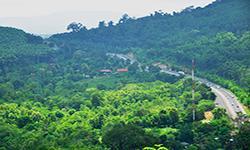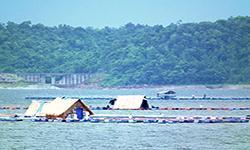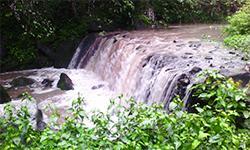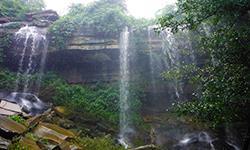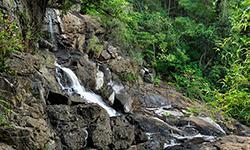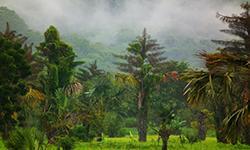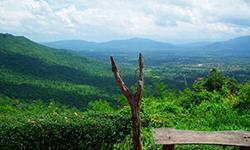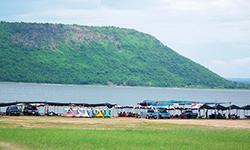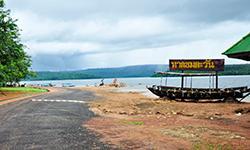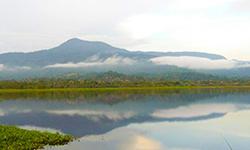Thap Lan National Park
Contact Location : Thap Lan National Park, 520 Moo. 1, Sai 304 Road, Kabinburi - Pak Thong Chai, Bu Phram Sub-district, Na Di District, Prachin Buri Province, 19220
Telephone Number : (+66) 3 721 0340, (+66) 9 2550 0172
Email : thaplannp01@gmail.com
Facebook : Thap Lan National Park
Information
Thap Lan National Park covers the areas in Pak Thong Chai, Wang Nam Khiao, Khon Buri and Soeng Sang District of Nakhon Ratchasima Province, and Na Dee District of Prachinburi Province. The forest conditions are fertile. Additionally, there is a Fan Palm forest , which is rare and only exists in certain areas. Lan trees or Fan palms grow naturally. The forest is responsible for numerous rivers and streams, and consists of stunning natural features such as canyons, cliffs, and waterfalls. It is the second-largest national park in Thailand, with approximately 1,397,375 rai, or 2,235.80 square kilometers.
Background
In the past, fertile fan palm forests were scattered throughout the northeast. Later, with the expansion of agricultural areas, the fan palm forests were greatly destroyed. At present, the last remaining fan palm forest is at Ban Thap Lan, Ban Khun Si, Ban Buprahman. and Ban Wang Dam of Prachinburi Province. In a visit to inspect the fan palm forest condition on March 24, 1974, Mr. Pradit Wanapitak, Director-General of the Royal Forest Department, found that it is the last Fan palm forest in the country. Therefore, in order to conserve the Fan Palm forest, the Director-General decided to establish this forest which has an area of approximately 36,250 rai or 58 square kilometers to be a forest park.
At the meeting of the National Park Committee No. 1/2518 on April 4, 1975, it was resolved to embark on an action plan for the Fan Palm forest in Parchinburi. Later, Prachinburi Regional Forest Office issued an order No. 169/2518 dated April 11, 1975 and an order No. 194/2518 dated April 15, 1975 for Mr. Suchon. Phatisena, a Forestry Technical Officer and Mr. Yan Thaksungnoen, a Provincial Forestry Officer, under the supervision of Mr. Pairote Chiew-Iamwattana, a Forestry Officer, to conduct a survey of boundaries and improve the areas to be a Pa Lan Forest Park in the area of Kaeng Dinso - Kaeng Yai - Khao Saton National Reserved Forest, Prachinburi Province
Later, the National Park Division, Royal Forest Department, issued an order No. 2383/2520 dated December 8, 1977, for Mr. Chaovalit Lertchayantri, a Forestry Technician Officer Level 5, to serve as the superintendent of Thap Lan Forest Park. In 1980, the National Park Division instructed Thap Lan Forest Park Office to explore the nearby areas of the forest park in order to combine it with the forest park, raising Thap Lan Forest Park to the status of a national park. According to the survey results, Ko So No. 0708 (Tho Lo)/16, dated February 25, 1980, the surrounding forests are abundant, featuring stunning scenery and an abundance of wildlife and are the headwaters of the Bang Pakong River and the Mun River.
In response to a Cabinet resolution on January 9, 1979, Thap Lan forest was declared a national park to preserve the forest. The royal forest department proposed to the National Park Board, which was resolved in meeting No. 2/2523 on August 8, 1980, that it be appropriate to issue a royal decree designating the forest area as a national park, specifying the areas of: Wang Nam Khiao Forest and Khon Buri Forest in Sakae Rat and Wang Nam Khiao Sub-district, Pak Thong Chai Distict, Khon Buri, Chorakae Hin and Khok Krachai Sub-district, Khon Buri District, Sa Takhain and Non Sombun Sub-district, Soeng Sang District of Nakhon Ratchasima Province and Kaeng Dinso Forest, Kaeng Yai Forest, and Khao Saton Forest are located in Bu Phram and Thung Pho Sub-district, Na Di District of Prachinburi Province. It was announced to be a national park in the Government Gazette, Volume 98, Section 210, dated December 23, 1981, as the country's 39th national park.
Later, there was a cabinet resolution on June 7, 1988, allowing the Royal Irrigation Department to use the area in Thap Lan National Park that consists of Wang Nam Khiao Forest, Khon Buri Forest, Kaeng Dinso Forest, Kaeng Yai Forest, Khao Saton Forest, and some areas of Chorakhe Hin Sub-district, Khon Buri District, Nakhon Ratchasima Province to construct the Mun River Reservoir which covers an area of 2,625 rai, or 4.20 square kilometers in order to develop the Northeastern region. The Ministry of Agriculture and Cooperatives therefore had to revoke this part of the area in accordance with The royal decree.
In 1989, a royal decree was issued to revoke the Wang Nam Khiao National Park, Khon Buri Forest, Kaeng Dinso Forest, Kaeng Yai Forest, Khao Saton Forest, and Chorakhe Hin Sub-district, Khon Buri District of Nakhon Ratchasima Province from being a national park as previously defined by the decree of 1981 and announced in the Government Gazette, Volume 106, Section 107, dated July 7, 1989.
Note : After paying the entrance fee to the National Park, please carry the receipt for inspection.

1,397,375 rai (2,235.8 square kilometers)
|
|
|
||
|
Bo Thong Waterfall |
Man Fa Waterfall |
||
|
Suan Hom Waterfall |
Pa Lan |
||
|
Pha Kep Tawan |
Chom Thong Beach |
||
|
Chom Tawan Beach (Lam Plai Mat) |
Thap Lan Reservoir |
||
Nature trails ⇔ Bird/Butterfly
Welfare shop : (coffee, drinks, snacks) is open daily from 08:30 - 16:30 hrs.
Mobile phone signal :
1. Suan Hom Waterfall area: AIS
2. Pha Keb Tawan area: AIS, DTAC, TRUE
3. Chom Tawan Beach area: AIS
4. Chom Thong Beach area: AIS, TRUE
|
|
The terrain is a complex, folded mountain range, and the highest peak is Khao Lamang, about 992 meters above sea level. It consists of natural valleys, ravines, and waterfalls. It is the origin of Mun River and Bang Pakong River. In the area of the National Park Headquarters which is located in Bu Phram Sub-district, Na Di District, Prachin Buri Province, there are endemic plants, namely, fan palm trees. The area is regarded as the last fertile and beautiful Fan Palm forest in Thailand.
|
|
There are three seasons: summer, rainy season and winter. Summer starts in February or April every year, and some years it may last until May. Each year, rainy season begins in May and lasts until August, with the possibility of continuing until October. Winter starts from October to January every year. In winter, the weather in Wang Nam Khiao District, Nakhon Ratchasima Province will be cool and comfortable. In some very cold months, the temperature will be between 17 - 20 degrees Celsius. However, the climate is changing rapidly as a result of the global warming crisis. Therefore, it is best to inquire about the nature of tourism fromthe national park before traveling every time.
|
|
|
|
|
The plant society in this area is a very fertile lower mountain rainforest. The plant community in Thap Lan National Park is a vibrant lowland forest, which can be classified into four types: dry evergreen forest, tropical rain forest, mixed deciduous forest, and deciduous dipterocarp forest. In this plant community, the forest ecology of the central region overlaps with that of the northeastern region. There are numerous plant and animal species. Fan palms are densely distributed around Thap Lan National Park Headquarters, Bu Phram Sub-district, Na Di District, Prachin Buri Province, consisting of areas in Ban Thap Lan, Ban Khun Si, Ban Bu Phram, and Ban Wang Dam. Therefore, it is known as Thailand's final and most beautiful Fan Palm Forest. The Fan palm or Lan is a member of palm family, a monocot, and a medium-sized perennial plant with a height of around 10 – 26 meters. It has a straight and hard fibrous trunk. Young leaves are layered around the trunk. The petiole is about 3 – 4 meters long, and one branch has a mono leaf. The fan-shaped leaves are about 2 – 3 meters wide, and there is one Thai proverb saying, "People who have a habit of hitting their parents, their hands will be as big as fanleaf-palms after death." It has many special characteristics. For example, it has a lifespan of 60 - 80 years and it will bloom and bear fruit when it is old. The flowers are white, and the Fan palm will bloom only once before dying. After the seeds fall, the tree will begin to wither and immediately die. Wildlife resources The number of wildlife species in Thap Lan National Park, according to a survey of the Royal Forest Department (2000), was at least 321 vertebrate species, classified into the following categories: |
How to get there by car :
Traveling to Thap Lan National Park Headquarters (Pa Lan) by car can take two routes :
- Route No. 1 from Bangkok to Thap Lan National Park, take the Ongkharak - Nakhon Nayok - Prachin Buri route. The total distance is approximately 197 kilometers. The headquarters of Thap Lan National Park, located in Bu Phram Sub-district, Na Di District, Prachin Buri Province, is approximately 32 kilometers from the Kabin Buri Intersection (Kabin Buri - Pak Thong Chai).
- Route No. 2 from Nakhon Ratchasima Province, take the Pak Thong Chai - Kabin Buri route, Highway No. 304, a distance of about 107 kilometers to the National Park Headquarters. Visitors will discover the Lan or Fan Palm Forest, which is spread out over a large area. The headquarters is adjacent to the main highway.
- National Park Ranger Station Tho Lo No. 1 (Khlong Namman)
- National Park Ranger Station Tho Lo No. 2 (Lam Plai Mat)
- National Park Ranger Station Tho Lo No. 3 (Lam Praeng)
- National Park Ranger Station Tho Lo No. 4 (Khao Makha)
- National Park Ranger Station Tho Lo No. 5 (Huai Toei)
- National Park Ranger Station Tho Lo No. 6 (Wang Thalu)
- National Park Ranger Station Tho Lo No. 7 (Khao Mai Plong)
- National Park Ranger Station Tho Lo No. 8 (Taling Chan)
- National Park Ranger Station Tho Lo No. 9 (Lam Mafai)
- National Park Ranger Station Tho Lo No. 10 (Phu Lamyai)
- National Park Ranger Station Tho Lo No. 11 (Thai Samakkhi)
- National Park Ranger Station Tho Lo No. 12 (Sap Sadao)
- National Park Ranger Station Tho Lo No. 13 (Suan Hom)
- National Park Ranger Station Tho Lo No. 14 (Lampiek)
- National Park Ranger Station Tho Lo No. 15 (Chom Thong)
- National Park Ranger Station Tho Lo No. 16 (Bo Thong)
- National Park Ranger Station Tho Lo No. 17 (Dan Lako)
- National Park Ranger Station Tho Lo No. 18 (Sap Mek)
- National Park Ranger Station Tho Lo No. 19 (Ban Khlong Krathing)
- National Park Ranger Station Tho Lo No. 20 (Huai Kham Phu)
- Accommodation: Thap Lan 204-205 (Suan Hom)

